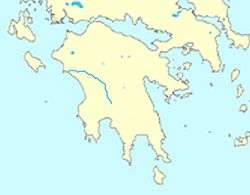Alfeios
| Alfeios | |
|---|---|
 | |
| Country | Greece |
| Physical characteristics | |
| Main source | Peloponnese |
| River mouth |
Ionian Sea 37°36′45″N 21°27′6″E / 37.61250°N 21.45167°ECoordinates: 37°36′45″N 21°27′6″E / 37.61250°N 21.45167°E |
| Length | 110 km (68 mi) |
| Basin features | |
| Tributaries |
|
Alfeiós (Greek: Αλφειός, also romanized as Alpheus, Alpheios) is the longest river in the Peloponnese, in Greece. The river is 110 kilometres (68 mi) long,[1] flowing through the regional units of Arcadia and Elis. Its source is near the village Dorizas, about halfway between Tripoli and Megalopoli in the highlands of Arcadia. It flows southwest toward Megalopoli, where it has been diverted around open pit lignite mines. At Thoknia it receives its right tributary Elissonas, and continues north towards Karytaina. Below Karytaina the Lousios flows into the Alfeios, and the Alfeios continues northwest, passing north of Andritsaina. Near Tripotamia the rivers Ladon and Erymanthos flow into the Alfeios. The Alfeios then flows west along Olympia and empties into the Ionian Sea south of Pyrgos.
The ancient highway linking Patras and Kalamata ran along this river for most of the length east of Olympia.
In Greek mythology, the Peneus and Alpheus were two rivers re-routed by Heracles in his fifth labour in order to clean the filth from the Augean Stables in a single day, a task which had been presumed to be impossible. A poem by Roger Caillois, called Le fleuve Alphée (the Alpheus River), is mainly about this river.
In the Aeneid, Virgil describes the Alpheus as flowing under the sea to resurface at Ortygia on Sicily, or "so runs the tale".[2]
References
- ↑ Greece in Figures January - March 2018, p. 12
- ↑ Aeneid, Book III, 694–696
External links
| Wikisource has the text of the 1911 Encyclopædia Britannica article Alpheus. |